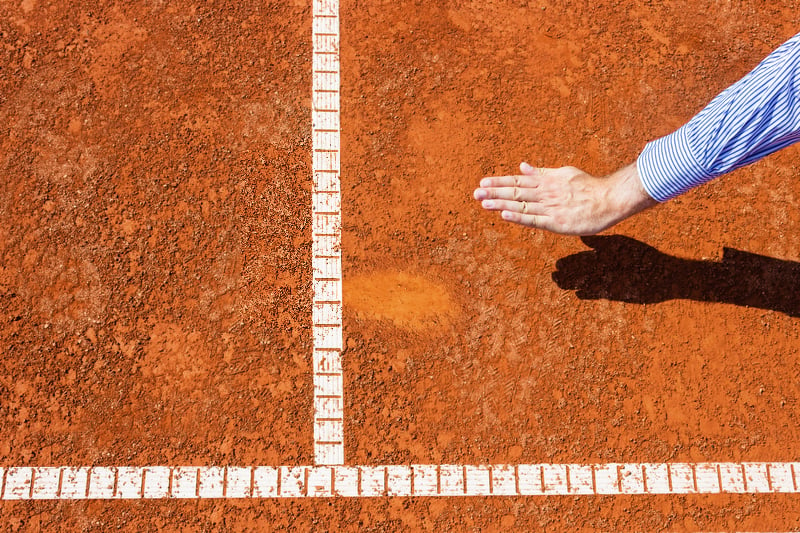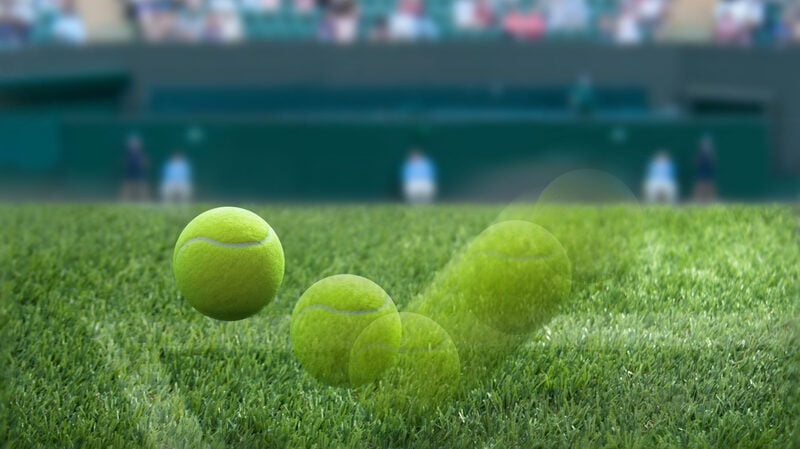Hawk-Eye In Tennis: How Does It Work?

There’s been a major focus over the last few years to try to get referee and umpire calls as accurate as possible across sports. Tennis is a bit ahead of the curve in a lot of ways, and Hawk-Eye is too thanks for that.
How exactly does Hawk-Eye work in tennis? It seems like a simple process in theory, but a lot goes into getting the calls right quickly and consistently.
How The Hawk-Eye System Works
The Hawk Eye system in tennis is based on triangulation using visual images, as well as timing data provided by video cameras.
Tennis currently uses 10 cameras on each court for the Hawk-Eye system to work. There’s a predefined model of the exact playing area, and the tennis court is perfect because the dimensions never change.
With each frame captured by the 10 cameras, the system will identify what pixels are part of the traveling ball. The technology is so great that it can even predict the flight of a ball in the future. This helps speed up the process and have a better understanding of what is in and what is out.
The system in place will generate a graphic image of the ball as it’s moving through the playing area. This is what viewers get a chance to see on the screen at matches.
Although the graphic is not available in real-time, calls can be made in real-time with the Hawk Eye system. That’s why it’s been able to take over in even the most contested matches.
What Caused the Need for the Hawk-Eye System In Tennis?
Tennis line call arguments have been going on since the beginning of the game. However, technology was never there to have anyone other than humans call lines. That was hard to change in the 1990s, but companies worked on systems that would help. By 2004, there was an auto ref system being tested out.
During the 2004 U.S. Open, the auto ref system was in place in New York City. Serena Williams lost to Jennifer Capriotti in one particular match that had a few questionable line calls. The auto ref system had no say in making calls, but it showed that a system could actually work and provide accurate feedback.
The 2006 season was the debut of Hawk-Eye in professional matches. It first appeared at the 2006 Hopman Cup, and other tournaments during the year gave it a try as well. The U.S. Open made it official at the Grand Slam level by offering two challenges per set, per player.
By 2007, the Australian Open and Wimbledon Championships were both using the Hawk-Eye system. Nearly every significant hard court and grass court tournament followed suit shortly after. The Hawk Eye system wasn’t originally available on every single court at a facility, but it would at least be on the main court for the most important matches.
Hawk-Eye and Clay Courts

The Hawk Eye system has proved to be very successful on grass and hard courts. However, a lot of clay-court tournament organizers have stayed away from the Hawk-Eye system.
There is less of a need on clay courts, as balls leave a mark that shows evidence if there’s ever a disputed line call. Chair umpires can come out of their chair and point out a spot on the clay to show if a ball is in or out.
Even with all the evidence on the ground, some clay-court tournaments are starting to give Hawk Eye a try as well. In 2021, the Madrid Open turned to an electronic system to help out with calls. Instead of using Hawk Eye, they used a system developed by FoxTenn.
What are the Official Rules of the Hawk-Eye System?
When the Hawk-Eye system first came out, tournaments were all over the place as far as what they would allow from players. That all changed in the spring of 2008, when the ATF, ATP, WTA, and Grand Slam committees got together and put together a unified set of rules.
A player gets three unsuccessful challenges per set, and an additional challenge if it goes to a tiebreak. Players who successfully get a call overturned do not lose any of their challenges. Theoretically, a player could challenge 10 or more calls in a set if they are successful in doing so.
You can learn more about hawk-eye and the challenge system in this post.
Advantages of the Hawk-Eye System

Players and fans seem to love the Hawk-Eye system in tennis. While it has its issues from time to time, it works almost perfectly due to the layout of a tennis court and what it’s responsible for handling.
These are the major advantages everyone sees in the Hawk-Eye System.
Fewer Delays
Hawk-Eye technology has gotten to the point that video reviews are quick and efficient. There are fewer delays when it comes to controversial calls, because there is proof right there for players and fantasy.
Tennis is already a relatively long sport, especially at Grand Slams when men play best-of-five sets. Being able to speed up the game in any way possible is always a positive.
Fewer Arguments
Arguing with the umpire might go back decades and tennis, but it’s generally looked at as a negative. Players very rarely argue successfully, and it can throw both opponents off of their game if done at the wrong time.
It’s hard to argue with technology and video proof that a ball is in or out. There will still be some minor arguments here and there, but Hawk-Eye greatly reduces those issues.
Decluttering of the Court
Tennis fans are used to having many different line judges on the court to make calls. Now that Hawk Eye is getting better and better, some tournaments are eliminating the need for line judges on the court.
Ultimately, this is going to be a good thing for tennis in general. It’s a way to declutter the court as much as possible, which can sometimes create some issues for players. There have been instances where players run after a ball and crash into a line judge.
Not only that, but there was the infamous case of Novak Djokovic hitting a ball that hit a lineswoman in the neck.
He was thoroughly punished for the offense, even if the angry mistake happened without intent. Having fewer people on the court eliminates these freak incidents.
Is the Hawk-Eye System Here To Stay?
The Hawk Eye system is like any new advancement in technology. It’s going to be around and prove to be very useful in tennis until something better comes along. It gets a lot right, and the people behind Hawk-Eye are always making tweaks to make improvements as well.
There’s always room for improvement with something like Hawk Eye. Getting calls done in real-time and making it more accessible will be the next step. It’s unlikely the Hawk-Eye will be on local courts anytime soon, but most professional tournaments should have it soon.
There’s still a need for chair umpires and other people to operate the system efficiently, but the days of traditional line calls are numbered at the highest level of tennis.
You can also read:
- How are ATP Tennis Rankings Determined?
- The 10 Best Australian Tennis Players of All-Time
- The 10 Best Spanish Tennis Players Ever
- 10 Things You Didn’t Know about Denis Shapovalov
- What Do Tennis Players Wear?






